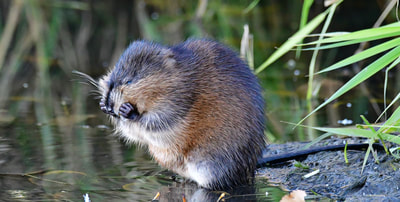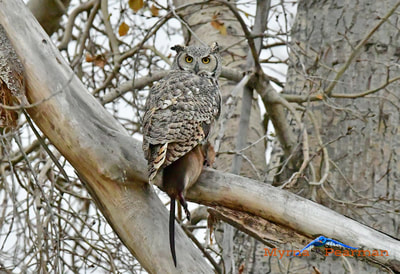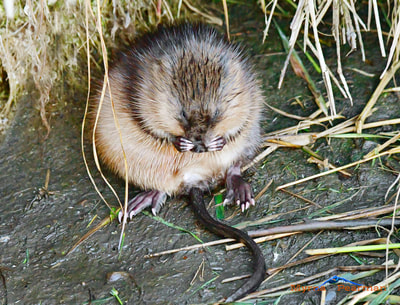 I am intrigued by muskrats. Over the past several years, I’ve enjoyed observing and photographing these busy little rodents. Fall is a good time of year to go muskrat watching, as their population is high and they can be seen busily preparing for winter. Muskrats have been in the national news recently, as animal rights groups are questioning the Canadian government’s decision to proceed with an order to kill 12,000 of these remarkable little animals so their fur can adorn RCMP winter hats. Animal defenders point out that muskrat trapping can be cruel and that an alternative insulating material could easily replace the muskrat fur on RCMP hats. My most recent muskrat encounters, both interesting and poignant, have been at Ellis Bird Farm (EBF). Following an onsite meeting not long ago, I ambled with a binocular-toting bird watcher friend down to the dipping pier. We were pleasantly surprised to count six muskrats. What a delight it was to watch them swim by, come out of the water to retrieve grass stems to eat, and even sit beside us and groom themselves. But I was surprised the bird watcher declared that one of the muskrats was swimming with an apple in its mouth! I immediately knew the source of the apple: about eight years ago, we planted a small apple orchard on the hillside by the Wetland Centre. The orchard produced a good crop this year, some of which ended up on the ground. The deer, the resident snowshoe hares and even the muskrats have discovered this candy store. After watching a sparring match between two apple-loving muskrats, my friend went up to the orchard and retrieved a few more apples. She placed them on a little mud patch beside the pier and, within seconds, two muskrats were seen racing to claim the prize. The winner set upon the apple with relish and promptly slurped it down. I was thrilled to be able to photograph the action. A few days later, I returned to the pond (with a few apples in my pocket) to see if the muskrats might still be active. As I rounded the corner by the apple orchard, I came face to face with Albert, our resident male Great Horned Owl. In his talons was a freshly killed muskrat. Albert flew west with his heavy load. He landed in one of the large poplar trees and draped the muskrat over a sturdy branch. I slowly approached him and, for a few long seconds, we held each other’s gaze. I’m not sure what he was thinking, but I found myself pondering the visceral reality of life and death. And I fretted about the possibility that we had inadvertently set up the perfect muskrat-killing system by planting an apple orchard at a perilous distance from the pond. It is my hope that the owls will spare a few muskrats so they can continue to grace our wetlands. I have proposed that we plant additional apple trees closer to water, so the fruit can fall into the tall and protective shoreline grass. I also look forward to offering the opportunity for our visitors (onsite and online via webcams) next season to watch and appreciate these fascinating and industrious wild neighbors. UPDATE: I visited the pond yesterday (October 20) and there were TWO muskrats dining on apples. Let's hope that they are a breeding pair so we can have more little muskrats enjoying apples next year! 31/3/2019 01:57:59 pm
Hi, My compliments to your muskrat photography. I found the bottom left image in my DuckDuckGo image search for muskrats. I live on the water and have had the pleasure of muskrat watching and they are top of the list of my favorite animals to watch. I am currently creating drawings toward a book featuring a muskrat character. Pleasantly I learned that they are typically nocturnal, which allows segue into depicting night life on the water - a magical world! Thanks again for your excellent photography.
Reply
harold horne
8/5/2020 09:35:21 pm
Have to drive far out to watch anything like this.cool ! man. Send us your potatoes and we,el turn them into alcohol. lol hh
Reply
Leave a Reply. |
AuthorMyrna Pearman Archives
August 2022
|
Re-posting these images or publishing is not permitted without Myrna's written consent.
Copyright Myrna Pearman Publishing 2024- Site design and maintenance by Carolyn Sandstrom






 RSS Feed
RSS Feed



20/10/2017
3 Comments